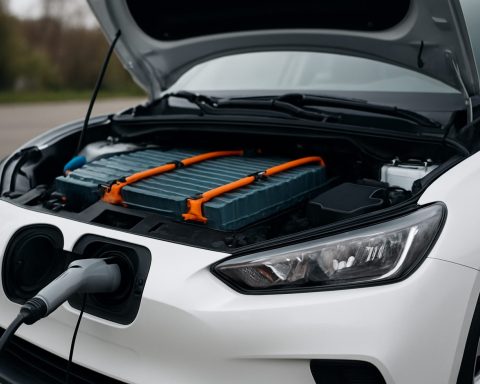Xirallic Pigment Manufacturing for Automotive Coatings in 2025: Unveiling Market Growth, Technological Breakthroughs, and the Road Ahead. Discover How Advanced Effects Are Shaping the Next Generation of Automotive Finishes.
- Executive Summary: 2025 Market Overview and Key Findings
- Global Market Size, Growth Rate, and Forecasts Through 2030
- Key Players and Competitive Landscape (e.g., merckgroup.com, toyoink.com)
- Technological Innovations in Xirallic Pigment Production
- Emerging Trends in Automotive Coating Applications
- Sustainability and Environmental Impact Initiatives
- Regional Analysis: Demand Drivers in North America, Europe, and Asia-Pacific
- Supply Chain Dynamics and Raw Material Sourcing
- Regulatory Landscape and Industry Standards (e.g., coatings.org, acea.auto)
- Future Outlook: Opportunities, Challenges, and Strategic Recommendations
- Sources & References
Executive Summary: 2025 Market Overview and Key Findings
The global market for Xirallic pigments—specialized effect pigments based on aluminum oxide platelets coated with metal oxides—continues to play a pivotal role in the automotive coatings sector in 2025. These pigments are prized for their unique sparkling and color-shifting effects, which enhance the visual appeal and perceived value of automotive finishes. The demand for Xirallic pigments is closely tied to trends in automotive design, consumer preferences for premium finishes, and the ongoing innovation in coating technologies.
As of 2025, the manufacturing landscape for Xirallic pigments remains highly consolidated, with Merck KGaA (operating under the brand “Xirallic®”) as the undisputed global leader. Merck’s Xirallic pigments are produced at its advanced facilities in Germany, where the company has invested in both capacity expansion and process optimization to meet rising demand from automotive OEMs and tier-one suppliers. The company’s focus on sustainability, including energy-efficient production and responsible sourcing of raw materials, aligns with the automotive industry’s broader push toward greener supply chains.
Other notable players in the effect pigment sector, such as BASF SE and Sudarshan Chemical Industries, have expanded their effect pigment portfolios, but Xirallic-type pigments remain a niche specialty dominated by Merck. These companies, however, are investing in R&D to develop alternative effect pigments with similar visual properties, aiming to diversify supply and address potential bottlenecks.
The automotive coatings market in 2025 is characterized by robust demand for high-performance, visually distinctive finishes, particularly in electric vehicles (EVs) and luxury segments. Automakers are increasingly specifying Xirallic pigments for signature colors and limited-edition models, driving steady growth in this pigment category. The Asia-Pacific region, led by China and South Korea, continues to be a major growth engine, both as a manufacturing hub and as a market for premium vehicles.
Key findings for 2025 indicate that supply chain resilience remains a strategic priority. The 2011 disruption at Merck’s Onahama plant in Japan underscored the risks of single-source dependency, prompting automakers and paint manufacturers to seek greater transparency and contingency planning. While Merck has since diversified its production footprint, the industry remains vigilant about potential vulnerabilities.
Looking ahead, the outlook for Xirallic pigment manufacturing is positive, with incremental capacity expansions and ongoing innovation in pigment chemistry expected over the next few years. The sector’s growth will be shaped by evolving automotive design trends, regulatory requirements for sustainable materials, and the pace of electrification in the global vehicle fleet.
Global Market Size, Growth Rate, and Forecasts Through 2030
The global market for Xirallic pigments—specialized effect pigments based on aluminum oxide platelets coated with metal oxides—continues to play a pivotal role in the automotive coatings sector. As of 2025, the demand for these pigments is driven by the automotive industry’s ongoing pursuit of visually striking, durable, and environmentally compliant finishes. Xirallic pigments are particularly valued for their unique sparkle and color travel effects, which enhance the aesthetic appeal of automotive exteriors.
The market is currently dominated by a few key manufacturers, with Merck KGaA (operating under the brand “Xirallic”) being the original developer and primary global supplier. Merck’s Xirallic pigments are produced at its Onahama plant in Japan, which has undergone significant capacity expansions in recent years to meet rising global demand. Other notable players include BASF SE and Sudarshan Chemical Industries, both of which have expanded their effect pigment portfolios to include products targeting the automotive sector.
In 2025, the global Xirallic pigment market for automotive coatings is estimated to be valued in the mid-hundreds of millions of USD, with a compound annual growth rate (CAGR) projected between 5% and 7% through 2030. This growth is underpinned by several factors:
- Increasing consumer demand for premium and customized vehicle finishes, especially in electric and luxury vehicle segments.
- Automotive OEMs’ focus on differentiation through advanced color and effect technologies.
- Regulatory trends favoring low-VOC and sustainable coating solutions, which Xirallic pigments can support due to their compatibility with waterborne and high-solid systems.
Regionally, Asia-Pacific remains the largest and fastest-growing market, led by China, Japan, and South Korea, where automotive production and innovation are robust. Europe and North America also maintain significant shares, driven by high-value vehicle manufacturing and consumer preference for unique finishes.
Looking ahead to 2030, the market outlook remains positive. Manufacturers such as Merck KGaA are investing in R&D to develop new pigment grades with enhanced weather resistance, color intensity, and sustainability profiles. Strategic collaborations between pigment producers and automotive OEMs are expected to accelerate the adoption of next-generation Xirallic pigments, further expanding their application scope in both exterior and interior automotive coatings.
Key Players and Competitive Landscape (e.g., merckgroup.com, toyoink.com)
The global market for Xirallic pigments—specialized effect pigments based on aluminum oxide platelets coated with metal oxides—remains highly concentrated, with a handful of major players dominating manufacturing and supply for automotive coatings. As of 2025, the competitive landscape is shaped by technological leadership, supply chain resilience, and strategic partnerships with automotive OEMs.
The undisputed leader in Xirallic pigment technology is Merck KGaA, headquartered in Darmstadt, Germany. Merck pioneered the Xirallic pigment family in the late 1990s and continues to be the primary global supplier. The company’s Xirallic® NXT series, launched in recent years, offers enhanced weather resistance and color intensity, specifically tailored for automotive exterior applications. Merck’s production facilities in Germany are vertically integrated, ensuring quality control and supply security, which is critical given the pigment’s complex manufacturing process and the automotive industry’s stringent requirements.
Another significant player is Toyo Ink SC Holdings Co., Ltd., based in Japan. Toyo Ink has developed its own effect pigment lines, including aluminum oxide-based products that compete in the high-end automotive coatings segment. The company leverages its expertise in pigment dispersion and surface treatment technologies to offer customized solutions for automakers, particularly in the Asia-Pacific region. Toyo Ink’s focus on R&D and close collaboration with Japanese automotive manufacturers positions it as a key regional competitor.
Other notable participants include BASF SE, which, while primarily known for its broad pigment and coatings portfolio, has expanded its effect pigment offerings to include products that rival Xirallic in certain applications. BASF’s global manufacturing footprint and established relationships with automotive OEMs provide it with a competitive edge, especially in Europe and North America.
The competitive landscape is further influenced by supply chain considerations. The 2011 Tōhoku earthquake, which temporarily disrupted Merck’s Xirallic pigment production, underscored the risks of supply concentration. Since then, automakers have sought to diversify their supplier base and encourage alternative sources, though Merck’s technological lead remains substantial.
Looking ahead to the next few years, competition is expected to intensify as automotive manufacturers demand more sustainable and innovative effect pigments. Key players are investing in greener production processes and next-generation pigment chemistries to meet evolving regulatory and consumer expectations. Strategic alliances, capacity expansions, and continued R&D will likely define the sector’s competitive dynamics through 2025 and beyond.
Technological Innovations in Xirallic Pigment Production
The manufacturing of Xirallic pigments—specialized effect pigments based on synthetic mica platelets coated with metal oxides—has seen significant technological advancements in recent years, particularly as the automotive industry demands ever more sophisticated and durable finishes. As of 2025, the focus within the sector is on improving pigment brilliance, color consistency, and environmental sustainability, while also enhancing production efficiency and supply chain resilience.
The core technology behind Xirallic pigments was pioneered by Merck KGaA, which remains the leading global producer. Their Xirallic® line is renowned for its high transparency, exceptional gloss, and unique sparkling effects, which are highly sought after in automotive coatings. Recent innovations by Merck KGaA include the development of new synthetic mica substrates that offer improved purity and platelet uniformity, resulting in more intense and consistent color effects. The company has also invested in advanced coating technologies that allow for thinner, more uniform metal oxide layers, further enhancing the optical properties of the pigments.
Sustainability is a growing priority in pigment manufacturing. Merck KGaA has publicly committed to reducing the environmental impact of its pigment production by optimizing energy use, minimizing waste, and increasing the use of renewable raw materials. The company’s recent investments in green energy and closed-loop water systems at its pigment manufacturing sites are expected to set new industry benchmarks for eco-friendly production.
Other key players, such as BASF SE and Sudarshan Chemical Industries, are also advancing their effect pigment portfolios, though their focus is more diversified across various effect pigment types. Both companies have reported ongoing R&D efforts to improve the weather resistance and processability of effect pigments for automotive applications, with a particular emphasis on compatibility with waterborne and low-VOC coating systems.
Automation and digitalization are transforming Xirallic pigment manufacturing. The integration of real-time process monitoring, AI-driven quality control, and advanced particle size analysis is enabling manufacturers to achieve tighter tolerances and faster scale-up from lab to production. These technologies are expected to reduce batch-to-batch variability and improve supply reliability, which is critical for automotive OEMs seeking consistent color matching across global production sites.
Looking ahead, the outlook for Xirallic pigment manufacturing is positive, with continued investment in both product innovation and sustainable production practices. As automotive design trends increasingly favor unique, high-impact finishes, demand for advanced effect pigments like Xirallic is projected to grow, driving further technological progress in the sector.
Emerging Trends in Automotive Coating Applications
Xirallic pigments, renowned for their intense sparkle and unique color effects, have become a cornerstone in the evolution of automotive coatings. As of 2025, the manufacturing landscape for these pigments is shaped by technological innovation, sustainability imperatives, and shifting market demands. Xirallic pigments are based on synthetic mica platelets coated with metal oxides, offering superior brilliance and weather resistance compared to traditional pearlescent pigments.
The primary manufacturer and patent holder of Xirallic pigments is Merck KGaA, operating under its Performance Materials division. Merck’s Xirallic® product line is produced at its Onahama plant in Japan, which has undergone significant capacity expansions and process optimizations in recent years to meet the growing demand from the automotive sector. The company’s focus has been on enhancing pigment purity, particle size control, and color consistency, which are critical for the high-quality finishes required by automotive OEMs.
In 2025, the automotive industry’s push for more sustainable and environmentally friendly coatings is influencing Xirallic pigment manufacturing. Merck KGaA has invested in greener production processes, including the use of renewable energy and closed-loop water systems at its facilities. Additionally, the company is developing new pigment formulations that reduce the reliance on heavy metals and hazardous substances, aligning with increasingly stringent global regulations on chemical safety and environmental impact.
Another emerging trend is the customization of Xirallic pigments to enable unique, brand-specific finishes for automotive manufacturers. This involves close collaboration between pigment producers and automotive OEMs to develop bespoke color effects that enhance vehicle differentiation. The demand for such customization is particularly strong in the premium and electric vehicle segments, where visual identity is a key market driver.
Supply chain resilience remains a focal point following past disruptions, such as the 2011 earthquake in Japan that temporarily halted Xirallic pigment production. In response, Merck KGaA has diversified its logistics and raw material sourcing strategies to ensure consistent supply to automotive customers worldwide.
Looking ahead, the outlook for Xirallic pigment manufacturing in automotive coatings is robust. The continued electrification of vehicles, coupled with consumer preferences for striking and durable finishes, is expected to drive further innovation and capacity investments. As the only major producer, Merck KGaA is likely to maintain its leadership, though ongoing R&D may open opportunities for new entrants or alternative effect pigments in the coming years.
Sustainability and Environmental Impact Initiatives
Sustainability and environmental impact have become central concerns in the manufacturing of Xirallic pigments for automotive coatings, especially as regulatory pressures and consumer expectations intensify in 2025 and beyond. Xirallic pigments, known for their unique crystal effect and high chroma, are primarily based on aluminum oxide platelets coated with metal oxides. The production process, historically energy-intensive and reliant on specific raw materials, is undergoing significant transformation to align with global sustainability goals.
The primary manufacturer of Xirallic pigments is Merck KGaA, which operates under the brand name “Xirallic®”. In recent years, Merck KGaA has publicly committed to ambitious sustainability targets, including achieving climate neutrality in its operations by 2040. The company has invested in energy-efficient technologies and process optimization at its pigment production facilities, notably in Germany, to reduce greenhouse gas emissions and water consumption. These efforts include the integration of renewable energy sources and closed-loop water management systems, which are expected to further mature and expand through 2025.
A key environmental concern in Xirallic pigment manufacturing is the sourcing and processing of aluminum oxide and titanium dioxide, both of which have significant ecological footprints. Merck KGaA has initiated supplier engagement programs to ensure responsible sourcing of raw materials, emphasizing traceability and reduced environmental impact. Additionally, the company is exploring alternative coating materials and process chemistries to minimize hazardous byproducts and improve recyclability of pigment-containing waste streams.
In the automotive coatings sector, OEMs are increasingly demanding pigments that comply with stricter VOC (volatile organic compound) and heavy metal regulations. Xirallic pigments, being inorganic and free from heavy metals such as lead and chromium, are well-positioned to meet these requirements. BASF SE, a major supplier of automotive coatings, collaborates with pigment manufacturers to develop formulations that maximize color effect while minimizing environmental impact. BASF’s sustainability initiatives include the use of life cycle assessment (LCA) tools to evaluate and reduce the carbon footprint of coatings, including those containing Xirallic pigments.
Looking ahead, the outlook for sustainable Xirallic pigment manufacturing is positive. Industry leaders are expected to further invest in green chemistry, circular economy approaches, and digital process monitoring to enhance resource efficiency. As automotive OEMs and tier suppliers intensify their sustainability commitments, demand for environmentally responsible effect pigments like Xirallic is projected to grow, driving continued innovation and collaboration across the value chain.
Regional Analysis: Demand Drivers in North America, Europe, and Asia-Pacific
The demand for Xirallic pigments in automotive coatings is shaped by distinct regional drivers across North America, Europe, and Asia-Pacific, reflecting differences in automotive production, consumer preferences, and regulatory environments. As of 2025, these regions collectively represent the core markets for Xirallic pigments, which are prized for their unique luster and color effects in high-end vehicle finishes.
In North America, the automotive sector remains a significant consumer of Xirallic pigments, driven by the continued popularity of premium vehicles and pickup trucks, which often feature advanced metallic and pearlescent finishes. The United States, home to major automakers and a robust aftermarket customization culture, sustains steady demand for innovative coating technologies. Regulatory emphasis on environmental compliance is also prompting manufacturers to adopt pigments that are compatible with low-VOC and waterborne coating systems. Key suppliers such as Merck KGaA—the original developer and global leader in Xirallic pigment technology—maintain strong partnerships with North American automotive OEMs and paint manufacturers.
In Europe, the market is characterized by a focus on sustainability and design innovation. European automakers, renowned for luxury and performance brands, are early adopters of advanced pigment technologies to differentiate their vehicles. The region’s stringent environmental regulations, including REACH compliance, drive the adoption of pigments with improved safety and environmental profiles. Merck KGaA operates significant manufacturing and R&D facilities in Germany, ensuring a stable supply of Xirallic pigments tailored to European standards. Additionally, collaborations between pigment manufacturers and automotive paint suppliers such as BASF and Axalta foster innovation in color styling and application techniques.
The Asia-Pacific region, led by China, Japan, and South Korea, is the fastest-growing market for Xirallic pigments in automotive coatings. Rapid expansion of automotive manufacturing, rising consumer demand for visually distinctive vehicles, and the proliferation of electric vehicles (EVs) are key growth drivers. Local and international pigment producers are investing in capacity expansions and technical service centers to meet the needs of regional automakers. Merck KGaA has established production and distribution networks in Asia, while companies like Toyo Ink Group and Sudarshan Chemical Industries are expanding their portfolios to include effect pigments for automotive applications.
Looking ahead, the outlook for Xirallic pigment demand in these regions remains robust, underpinned by ongoing automotive innovation, evolving consumer tastes, and regulatory trends favoring advanced, environmentally responsible coating solutions.
Supply Chain Dynamics and Raw Material Sourcing
The supply chain dynamics and raw material sourcing for Xirallic pigment manufacturing in automotive coatings are characterized by a high degree of specialization and sensitivity to global events. Xirallic pigments, renowned for their unique sparkling effect and color depth, are based on aluminum oxide (alumina) platelets coated with metal oxides. The production process is technologically intensive, requiring high-purity raw materials and advanced coating techniques.
The primary producer and patent holder of Xirallic pigments is Merck KGaA, which operates its main production facility in Onahama, Japan. This facility is critical to the global supply, as Merck’s Xirallic pigments are widely used by leading automotive OEMs for premium finishes. The reliance on a single major production site introduces supply chain vulnerabilities, as demonstrated in 2011 when the Fukushima earthquake temporarily disrupted pigment availability, leading to production delays for several automakers.
Raw material sourcing for Xirallic pigments centers on high-purity alumina, which is sourced from specialized suppliers capable of meeting stringent quality requirements. The alumina must be of exceptional purity and specific platelet morphology to ensure the desired optical effects. Metal oxides such as titanium dioxide and iron oxide, used for coating the alumina platelets, are also sourced from established chemical suppliers with robust quality control systems. BASF and Huntsman Corporation are among the global leaders in supplying these essential raw materials, supporting pigment manufacturers with consistent quality and supply reliability.
In 2025, the Xirallic pigment supply chain is adapting to several trends. First, there is a growing emphasis on supply chain resilience, with manufacturers exploring options for geographic diversification of production and raw material sourcing. This is partly in response to lessons learned from past disruptions and ongoing geopolitical uncertainties. Second, sustainability is becoming a key consideration, with companies like Merck KGaA investing in greener production processes and seeking suppliers with strong environmental credentials.
Looking ahead, the outlook for Xirallic pigment supply in the automotive sector remains positive, but contingent on continued investment in supply chain robustness and raw material quality. As demand for high-end automotive finishes grows, especially in electric and luxury vehicles, the importance of secure and sustainable sourcing for Xirallic pigments will only increase. Industry leaders are expected to further strengthen partnerships with raw material suppliers and invest in technological innovations to ensure consistent supply and meet evolving regulatory and market demands.
Regulatory Landscape and Industry Standards (e.g., coatings.org, acea.auto)
The regulatory landscape for Xirallic pigment manufacturing in automotive coatings is shaped by evolving environmental, health, and safety standards, as well as industry-specific quality requirements. Xirallic pigments, known for their unique luster and color effects, are primarily based on aluminum oxide platelets coated with metal oxides. Their production and use are subject to both chemical regulations and automotive sector standards, which are tightening in 2025 and beyond.
In the European Union, the European Automobile Manufacturers’ Association (ACEA) and the British Coatings Federation (representing the coatings sector) play significant roles in shaping industry standards. The EU’s REACH regulation continues to be a central framework, requiring manufacturers and importers of chemical substances—including those used in Xirallic pigments—to register and provide safety data. The focus on sustainability and reduction of hazardous substances is intensifying, with stricter limits on volatile organic compounds (VOCs) and heavy metals in coatings. This is prompting pigment manufacturers to innovate with cleaner processes and alternative raw materials.
In North America, the American Coatings Association (ACA) is instrumental in developing voluntary standards and advocating for regulatory compliance. The ACA works closely with the U.S. Environmental Protection Agency (EPA) to ensure that pigment and coating manufacturers adhere to the Toxic Substances Control Act (TSCA) and related air quality regulations. The trend in 2025 is toward harmonization of standards with global partners, particularly regarding chemical safety and environmental impact.
Automotive OEMs are increasingly demanding compliance with global standards such as ISO 9001 (quality management) and ISO 14001 (environmental management), which are now prerequisites for suppliers of Xirallic pigments. The push for lifecycle assessments and end-of-life recyclability of coatings is also influencing pigment formulation and manufacturing practices.
Major pigment producers, such as Merck KGaA—the original developer of Xirallic pigments—are actively engaged in industry working groups to shape future standards. Merck KGaA emphasizes compliance with international chemical regulations and participates in sustainability initiatives to reduce the environmental footprint of its pigment production.
Looking ahead, the regulatory environment is expected to become even more stringent, with increased scrutiny on nanomaterials and the carbon footprint of pigment manufacturing. Industry bodies are collaborating to develop new test methods and certification schemes, ensuring that Xirallic pigments meet both performance and sustainability criteria for next-generation automotive coatings.
Future Outlook: Opportunities, Challenges, and Strategic Recommendations
The future outlook for Xirallic pigment manufacturing in automotive coatings is shaped by evolving industry demands, regulatory pressures, and technological advancements. As of 2025, the automotive sector continues to prioritize unique visual effects and enhanced durability in exterior finishes, driving sustained demand for high-performance effect pigments such as Xirallic. These pigments, based on synthetic mica substrates coated with metal oxides, offer exceptional sparkle and color travel, making them highly sought after for premium and electric vehicle (EV) models.
A key player in this market is Merck KGaA, which pioneered Xirallic pigments and remains the primary global supplier. The company’s production facilities, notably in Germany, have undergone significant investments to increase capacity and ensure supply chain resilience following past disruptions. Merck’s ongoing R&D focuses on expanding the color palette, improving weather resistance, and developing more sustainable manufacturing processes to align with automotive OEMs’ environmental targets.
Opportunities in the coming years are closely tied to the automotive industry’s shift toward electrification and personalization. EV manufacturers are leveraging Xirallic pigments to differentiate their models with striking finishes that emphasize innovation and luxury. Additionally, the growing trend of custom and limited-edition vehicles is expected to boost demand for novel pigment effects. Strategic collaborations between pigment manufacturers and automotive OEMs are likely to intensify, with joint development projects aimed at creating exclusive color solutions.
However, the sector faces several challenges. The production of Xirallic pigments is capital- and technology-intensive, with stringent quality control requirements to ensure consistency and performance. Supply chain vulnerabilities, as highlighted by the 2011 disruption at Merck’s Onahama plant, remain a concern, prompting manufacturers to diversify sourcing and invest in risk mitigation strategies. Furthermore, regulatory scrutiny over the use of certain metal oxides and the environmental impact of pigment production is increasing, necessitating ongoing innovation in raw material selection and process efficiency.
Strategic recommendations for stakeholders include investing in advanced manufacturing technologies to enhance product quality and throughput, as well as adopting circular economy principles to minimize waste and environmental footprint. Close collaboration with automotive OEMs will be essential to anticipate design trends and regulatory shifts. Finally, expanding global production footprints and building robust contingency plans will be critical to ensuring supply security and meeting the evolving needs of the automotive coatings market.










